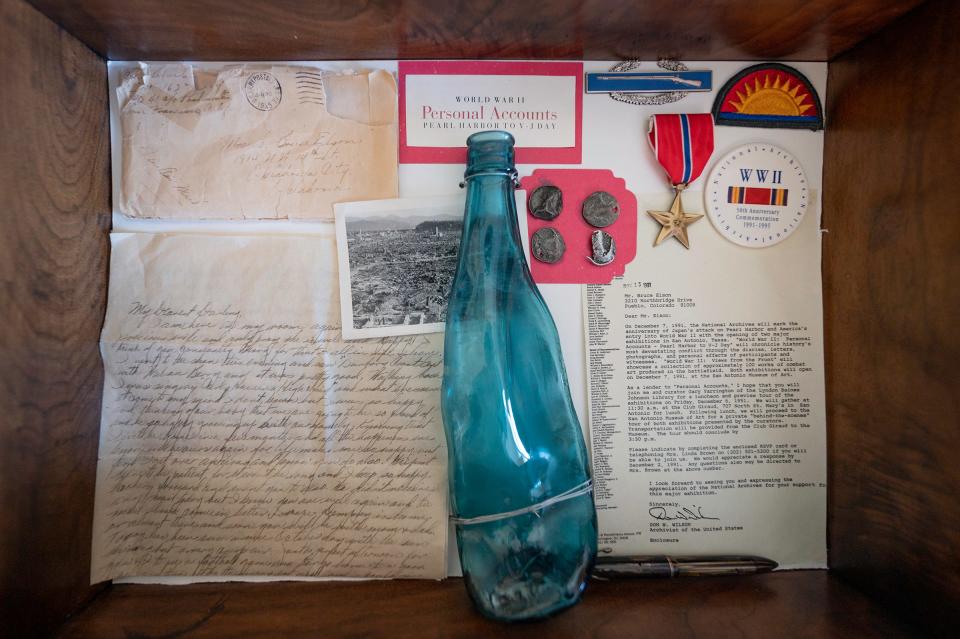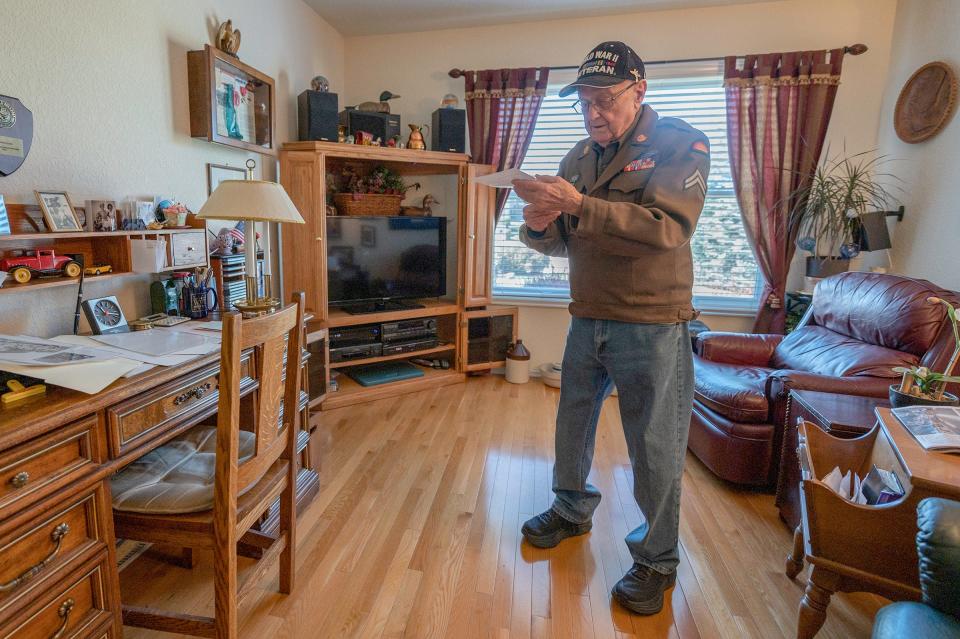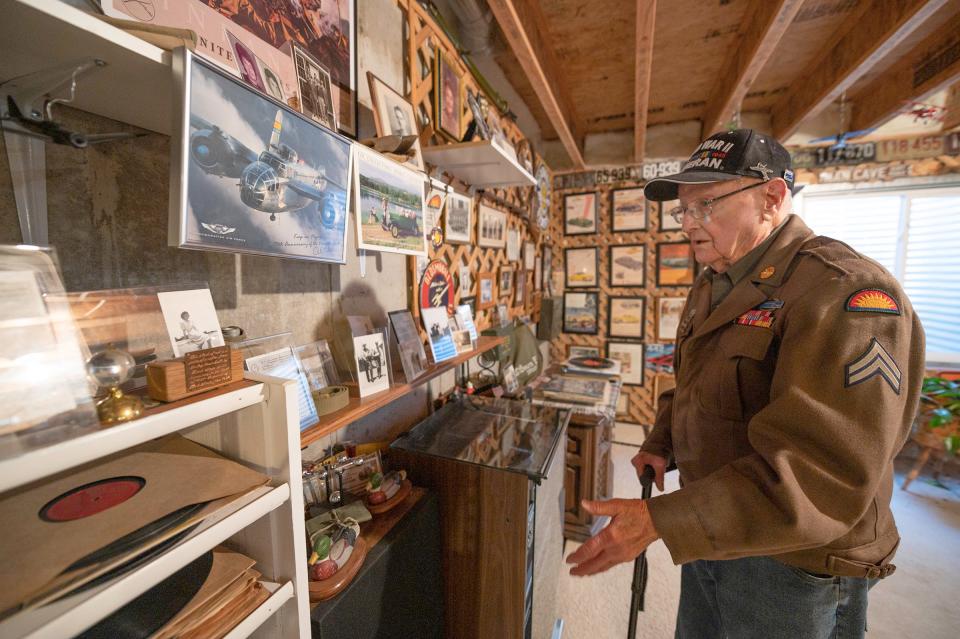Pueblo WWII veteran who visited Hiroshima after atomic bomb reflects on life and service
- Oops!Something went wrong.Please try again later.
World War II Army Air Corps veteran Bruce Elson, soon to be 100 years old, vividly recalls visiting the Japanese city of Hiroshima six weeks after it was hit by an atomic bomb dropped by U.S. forces.
"The men were begging for cigarettes, the children, of course, were begging for chocolate," he said.
Photos taken by Elson showed devastation on the streets. He recalled seeing a shadow on a wall where a victim was vaporized by the force of the bomb, and ruins of burned-out buildings among the twisted metal and rubble.
On a wall in his home in Pueblo, Elson still keeps what was a bottle of Sake, the glass of which was fused and melted from the atomic explosion.

Despite the overwhelming destruction, Elson said he does not regret the United States' usage of the bomb. He said he agrees with Paul Tibbets, pilot of the B-29 bomber Enola Gay, which dropped the bomb on Hiroshima.
"Tibbets was often asked after the war, 'Do you have any regrets?' and he would say, 'No, (the use of the atomic bomb) saved millions of lives and ended the war," Elson said.
Elson, who will join Pueblo's centenarian club later this month when he turns 100, volunteered for the U.S. Army in 1942, when he was 18 years old.
Because of his poor eyesight, he said he couldn't technically enlist but volunteered to be drafted instead of waiting for his draft number to come up. "I was so afraid I'd be classified 4F (not qualified for military service)," he said. "Someone told me that if I drink a lot of carrot juice and eat carrots it's good for my eyes, so I probably looked like a carrot when I got there. But the doctor just said next, and shoved me right on through, no problem at all."
From there, Elson was assigned to the U.S. Army Air Corps. After training in Fort Collins, he was assigned to what was then Peterson Field in Colorado Springs.
Following the famous "Battle of the Bulge" in 1944, Elson's unit was deployed to the Pacific theater, to assist in the war against the Japanese.
His unit, the 41st Infantry Division, served in the Philippines before being deployed post-war to Japan.

During his service, Elson earned a Combat Infantry Badge, indicating that he saw combat during the war; a sharpshooter badge for the M1 Garand Rifle, M1 Carbine, and Thompson submachine gun; and a fruit salad of campaign ribbons.
Post-war, he said he made friends with a Japanese soldier, who had made his own pilgrimage to the Philippines to apologize for the actions of the Japanese in the Philippines during the war.
The soldier, Makoto Ikeda, spoke at an American reunion in the Philippines and apologized for the cruelties suffered by American POWs at the hands of the Japanese.
For five years, he exchanged letters with the soldier, as well as pictures of their families and pets. "He had grandchildren as I (did). They were taking piano lessons, so did mine; he had a beagle dog, so did I," Elson said. "All people are alike, and war is terrible, he said. It accomplishes nothing."
Elson was discharged in 1946 and worked for 44 years as a parts manager at Vidmar Motor Co, which sold Oldsmobiles. The company now serves as a Honda dealership.
"We were at a hole in a wall, down on Santa Fe, down on the corner from where they are now," he said.
Over his long life in Pueblo, Elson said the city has changed significantly.
"All of the old buildings down on Main Street were the heart of the city," he said. "Everybody went down there. There was Crews Bank, down on the corner at 4th and Main, White and Davis, a big department store... now, none of that. It's spread out all over, things are entirely different now."

Elson maintains a personal "museum" in his home full of both WW2 Army Air Corps memorabilia and car models, as well as books and other items of significance from throughout his life. Among the memorabilia are a sheathed katana and an M1 Garand rifle in a case. "That thing weighs 20 pounds," Elson said of his old rifle. "I don't know how I used to be able to carry it around."
In 2016, Elson was granted the rank of honorary commandant at the non-commissioned officer academy at Peterson. However, he said, he hasn't been to the base since the onset of the COVID-19 pandemic.
"It's even changed the academy — they don't have them too much together, they teach them by telecommunication," he said.
While his days of service are many years past, Elson can still be found volunteering at the Pueblo Weisbrod Aircraft Museum every other weekend.
Questions, comments, or story tips? Contact Justin at jreutterma@gannett.com. Follow him on X, formerly known as Twitter, @jayreutter1. Support local journalism, subscribe to the Chieftain at subscribe.chieftain.com.
This article originally appeared on The Pueblo Chieftain: Pueblo veteran visited Hiroshima six weeks after atomic bomb

